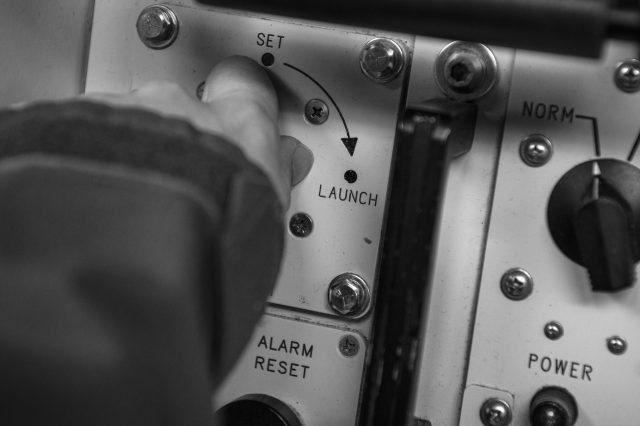
Nuclear weapons and their role in Australia’s future defence are being openly debated by some key thinkers in Canberra. A recent ASPI Strategic Insights paper by Paul Dibb and Richard Brabin-Smith highlights a worsening security outlook and reduction in strategic warning for major-power threats. Hugh White’s latest Quarterly Essay, ‘Without America’, raises the prospect of the US ceding the Asia–Pacific to a rising China, and examines Australia’s defence policy options in this much more contested security future. White suggests that Australia may need to re-examine nuclear weapons as an option, and Dibb has called for a review of the process and the technological lead time to acquire such weapons. Finally, ASPI’s Andrew Davies has pointed out that the logical endpoint of the analysis conducted by Dibb and Brabin-Smith and White is an Australian nuclear weapons capability.
So the topic is very much on the table. That’s a sign of how bad things may get in coming years. But realistically, what would be the triggers for Australia taking such a step?
It’s not in Australia’s interests to get nuclear weapons if the US’s extended nuclear deterrence security guarantees remain strong. Despite Donald Trump’s suggestions on the campaign trail that Japan and South Korea should get nuclear weapons and look after themselves, there’s no sign that extended nuclear deterrence has weakened now that he’s in office. If anything, President Trump’s talk of unleashing ‘fire and fury’ against the threat of North Korea’s nuclear weapons and missile programs reinforces concerns that he might rush to first use of nuclear weapons in coming months.
Yet Trump’s erratic approach to foreign policy contributes to a perception of US strategic decline. The marginalisation of the political centre, together with bitter partisan bickering, undermines Washington’s ability to make coherent policy. That in turn weakens its ability to fund defence modernisation and meet the growing challenges from China and Russia. It provides fertile ground for neo-isolationist sentiment that promotes ‘America first’–type thinking on the right and left—and that may go further than Trump’s rhetoric in the future. White makes that strong point in his essay, noting that ‘it is hard to see future candidates blithely assuming that America should keep the world safe for everyone else as well, and it is hard to see them winning many votes if they do’. Any perception of a weakened or imminent collapse of the US security commitment to Asia would be the first trigger for Australia to begin seriously considering nuclear capabilities.
If the US were to turn further inward, its extended nuclear deterrence guarantees would likely disappear over the horizon. At that point, Australia would be far more exposed to major-power coercive threats—especially from a revisionist China that would rush to fill a security vacuum in the Asia–Pacific. Australia is on that front line, and already subject to intensive soft-power influence campaigns by the Chinese Communist Party. Those could easily be backed by hard power through forward deployment of Chinese military forces into our air and maritime approaches, as China develops forward bases in the South China Sea and pursues long-range air and naval capabilities.
The dilemma for Australia is that by the time we get to that future, it may be too late to fast-track the acquisition of nuclear weapons. Nukes are complex. They require sophisticated research and development, sustainment infrastructure, and expertise that are currently absent in Australia. They also require complex and potentially expensive delivery systems, including road-mobile ballistic missiles, or more survivable submarine-launched missile systems. A survivable command and control network would be an essential and expensive capability. Plus, we’d need to think about nuclear deterrence, and that demands we think about warfighting.
Our ability to develop a nuclear capability is also constrained by our support for the international non-proliferation regime, including the 1968 Nuclear Non-Proliferation Treaty. That raises the second trigger for nuclear acquisition—the collapse of nuclear non-proliferation norms. This could happen if the US failed to prevent North Korea from acquiring a fully operational nuclear weapons capability with an effective ICBM delivery system, or if the Joint Comprehensive Plan of Action with Iran fell apart completely. In a worst-case scenario, non-proliferation norms could collapse quickly, particularly if the US decided at the same time to pull back from its security commitments and instead adopt either an ‘offshore balancer’ role or, worse, a neo-isolationist posture.
If Australia is challenged by a rising major power that is nuclear armed, and if US extended nuclear deterrence and nuclear non-proliferation norms are weakened or gone, we’d be in the worst of all futures—and we’d have to make some hard choices. A massive boost in conventional capability alone does nothing to counter nuclear coercion. Nor is ballistic-missile defence a total solution. Both land- and sea-based systems have yet to be tested under realistic conditions. The tests that have occurred have been only partially successful, and it’s always easier to overwhelm a defence with greater offensive capability. To deter nuclear threats requires nuclear weapons, and having such a capability would reinforce any future non-nuclear deterrent by dissuading escalation dominance. Australia would not consider such a step lightly, but don’t expect much time for deep consideration if our policymakers are forced to confront this option.